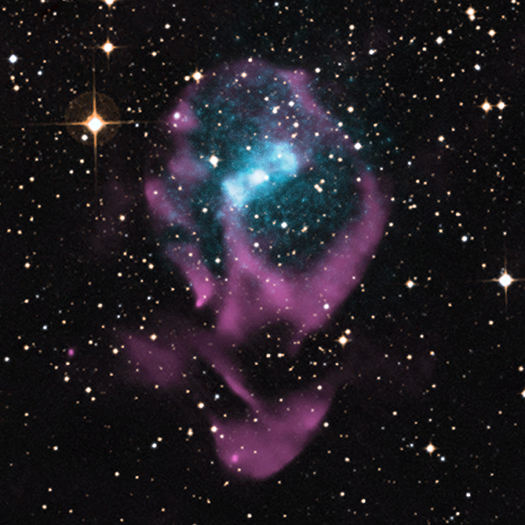Blast From Past Dates Youngest Neutron Star Binary

We'd like to welcome guest blogger Sebastian Heinz, Associate Professor in the Astronomy Department at the University of Wisconsin-Madison. He received his Ph.D. at the University of Colorado at Boulder. He studies relativistic jets -- a phenomenon observed around black holes and neutron stars, and began work on the project described here when he was a Chandra Postdoctoral Fellow at MIT.
Circinus X-1 had been a puzzle to X-ray astronomers almost from the moment of its discovery. It is an X-ray binary -- a neutron star sucking matter away from a companion star it is in orbit with, and it shines brightly when that matter spirals inward and eventually lands on the neutron star's surface. But it had defied classification into the basic categories scientists have been using for X-ray binaries. In some ways it behaves like a very young source, like the fact that the orbit of the two stars seems to change rapidly (and whenever things change rapidly in astronomy, we tend to infer that they cannot be very old). In other ways, it behaves like an old neutron star -- one that has lost most of the intense magnetic field which neutron stars are believed to be born with. It also blasts powerful streams of hot plasma, called jets, into interstellar space. And that's why I became interested. I study jets and I wanted to know why the jets from Circinus X-1 were able to light up and stay lit on scales of a few light years when other microquasar jets flared and then dimmed.
When we began planning this project about ten years ago, we were skeptical whether it could be successful. That's because Circinus X-1 was among the brightest X-ray sources in the sky for many years, and that meant that X-ray images of it suffered from enormous glare. Looking for faint traces of jets or other emission near Circinus X-1 would have been like looking for the planet Mercury next to the Sun in broad daylight. So we planned carefully and waited for Circinus X-1 to dim. In April 2009, we noticed that the source had completely disappeared from the X-ray monitors that scan the entire sky about every hour and we pulled the trigger on the Chandra observation we had been waiting so long to make: Circinus X-1 sans glare.
The image showed a never before seen faint X-ray glow surrounding Circinus X-1. When we combined the X-ray observation with a new radio image we took with the Australia Telescope Compact Array, we came to a surprising conclusion: the X-ray nebula is the residual glow of the supernova explosion that created the neutron star at the heart of Circinus X-1. That was a pretty startling discovery. X-ray binaries are typically many millions to billions of years old, but supernova remnants dissipate much more rapidly. X-rays are only visible for roughly 20,000 years, and the entire remnant disappears from view after a few hundred thousand years. Finding an X-ray binary inside a supernova remnant is like finding a butterfly in the moment it leaves its cocoon. It is a short instant in the beginning of its life. This meant that Circinus X-1 must be incredibly young compared to other X-ray binaries -- less than 4,600 years old when the light we observe now left the source. That makes it the youngest know X-ray binary by far.
With that realization, many of the pieces of the Circinus X-1 puzzle began falling into place. When X-ray binaries are born in a supernova explosion, the two stars that were orbiting each other for millions of years before are suddenly flung in new directions, making their new orbits very elliptical and unsteady (meaning, rapidly changing). This is exactly what had been observed for Circinus X-1. And even the wild swings in brightness over many years can be explained by the extreme youth of the object. The rotation axes of the neutron star and its companion are likely wobbling around, similar to the precession of the Earth's axis. And that means that sometimes the neutron star can grab on to matter from the surface of its companion much more easily than at others.
And the young age explains another puzzle: why the jets of Circinus X-1 are so bright. They are embedded in the pressure cooker environment of the supernova remnant, keeping the jet plasma hot and dense and, therefore, bright. The only other object that shows similar stable emission from light-year scale jets is the X-ray binary SS433, the second youngest X-ray binary in the Milky Way (about ten times older than Circinus X-1), and the only other X-ray binary inside its supernova remnant in our Galaxy. The two sources are remarkably similar in many other ways, though SS433 seems to contain a black hole rather than a neutron star. Perhaps nurture (the supernova remnant environment) is more important than nature (the type of compact object at the center) in young X-ray binaries.
But what about the magnetic field of the neutron star? Every so often, Circinus X-1 exhibits bright X-ray flashes, when the nuclear matter flowing from the companion star reaches critical mass and nuclear fusion ignites suddenly on a thin surface layer of the neutron star. This can only happen if the magnetic field is much lower than what is expected for a newborn neutron star, otherwise the matter would burn continuously, not in flashes. And, given the youth of Circinus X-1, that means one of two things: either neutron stars can, in fact, be born with much lower fields than theory had predicted, or the initial field in Circinus X-1 is easily pummeled by the massive amounts of gas dumped on its surface when it is close to its companion star on its elliptical orbit. Either of these possibilities poses exciting challenges to modelers of neutron star structure. This is one puzzle that remains unanswered by the new observations.
-Sebastian Heinz

